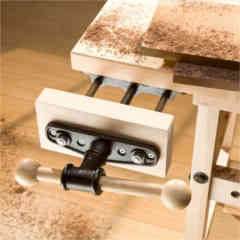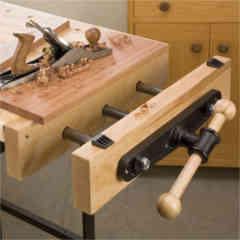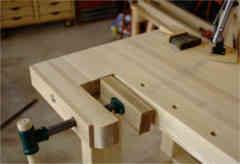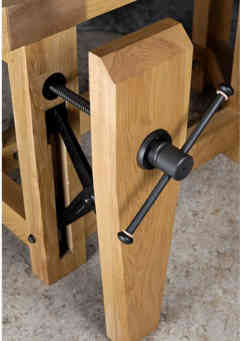Woodworking Bench Vise
A woodworking vise is one of the common staples of wood carving. They are more often used by those who work with hand tools of different varieties. Yet I have never seen a shop that did not have a woodworking bench vise of some kind.
The question becomes which vise is best? Perhaps I should phrase it this way. Which vise is the most common to be used in your daily projects? While there are many options out there some are more specialty than others.
This Is Not A Common Shop Vise
Before I get into details you need to know that this discussion is not the common shop vise you find at Lowes. The common bench vise is not for woodworking. This tool is more of a general purpose shop item.
This particular vise is often called an engineers vise or a machinists vise. I will say is that I have found it useful in some functions at times with wood. Yet it is not the best nor a practical solution in woodworking.
Face Vise
While there are several common variations you will often see a Face Vise in a shop. This is a Front Vise which is called front for it is positioned on the front of the workbench. While it will often be placed at the front corner it is possible to position it in other ways.

The Face Vise will come in two main variations. There is a steel or cast iron option and then of course wood. If you prefer steel know that you will need to make wooden jaw inserts or some have called them “shims”. These help protect your projects.
This vise is made to sit flush with the workbench top surface or what is often called the apron. The design allows for you to secure a long piece to the vise and then on the other end of the bench a clamp can be used. In this way added stability is gained for your project.
There are quick release versions of this vise and this does help in ease of use. Also know that if you notice the top portion of the jaw toeing in at first this is normal. As pressure is applied gripping wood it will go flush or parallel under pressure.
End Vise
An End Vise is as its name implies made to be used at the end of a workbench. This vise is one of the more useful variations. It typically uses the full width of the benchtop or apron. Its purpose is for holding larger or wider stock.

To install this vise know that it uses the end of the apron as one side of the jaws. In this way the workbench itself is part of the vise. A set of twin screws will guide the opposing jaw in and out to the apron.
A timing chain is often used which joins the twin screws in order to keep the jaws parallel to each other. It is a rather simple concept which adds a great deal of function helping to hold a piece firm for working.
Tail Vise
The Tail Vise is a variation of End Vise. Rather than using the full width of the apron on a bench it uses one corner. It has an L shape block of wood which will be used as the jaw. The opposing jaw to this L is the apron itself.

In constructing this vise a mortise will accept the lead screw. As the screw is turned the L piece will move in and out adjusting to hold the stock at that corner of your workbench.
The one added benefit to this vise is that there are two places where you can hold your wood. The L is the most obvious first place. The second is in between the bench and the moving block at the top of the L.
While this vise is more limited in what it can hold, for fine projects or smaller pieces it can do wonders. It helps to have a way to hold larger pieces as well as small.
Shoulder Vise
While a Shoulder Vise definitely has it cool factor and function it is not as common to find in shops. The idea is of Scandinavian origin and is designed to work with two tongues.

One tongue is fixed as it is a part of the apron itself. A screw goes through this tongue and meets the second tongue. A fixed rail allows the screw to move this second tongue in and out.
As this Vise is used the second tongue will apply pressure against the bench to secure your wood stock. This does have its advantages yet also it can make for some odd dimensions on the workbench. A corner of the benchtop must be sacrificed for these two tongues to be installed and operate.
Leg Vise

This vise is installed on the legs of the workbench. Its purpose is for holding large stock securely. Today as most people use modern machinery for planing and joining this vise is seen less and less in shops.
If one is desiring to use hand tools for every purpose possible then the Leg Vise is a must have. A pin system holds the lower part of the jaw while a screw allows the upper portion of the jaw to apply pressure. The bench leg itself acts as the opposing jaw.
As pressure is applied from the outside leg jaw a board can be held. This is common for planing edges or other shaping.
Wagon Vise

The Wagon Vise is another variation of the Tail Vise. While it is an End Vise I see its functionality being of less value than the Tail.
It may serve a specific purpose to some in application for their needs but will hold less value in more broad use.
Which Woodworking Vise Should Be Your First?
If you work with larger projects and material I would suggest an End Vise. If you use the full width of the apron you will gain a lot of surface area for holding stock secure. Yet this can be cumbersome for smaller projects.
With small projects the Face Vise is usually the most functional. It is not a complicated installation and it gives you plenty of room to work with off the corner of your apron. This is why it is one of the more common to find in woodworking shops.
Of these two I would say one of these would be your choice of the first to implement. Which one of these two would be determined by your work.
In the end I would say that it is a good idea to have both of them if possible installed on your woodworking table.
If you have these both and you still use machinery for many functions within woodworking then you will take care of most of your vise needs. There will come that specialty project which may need more attention, nevertheless 99% of what you need will be taken care of.
In my opinion the Tail Vise is more of a specialty vise. While it can be common to find it does not have as much to offer as the Face Vise. The Tail is limited by what the L can hold. It would depend largely upon how big you decide to make the L with the support that it would need.
The Difference Between A Vice and A Clamp
When you shop it does not take long to see some items being called a vice when it is more of a woodworking clamp. Specialty tools such as a Miter Vise exist for job specific purposes. Yet this is more like a clamp to hold two pieces together in creating something.
A traditional woodworking vise is designed for an altogether different purpose. The goal of a vise is to secure the lumber to the workbench so it acts as an additional set of hands. It allows you to perform tasks on the lumber without it moving.
Additionally a vise is a permanent fixture on the bench as compared to a clamp which can be used and then removed. While both can be at times interchanged in terminology they are not the same.
If you are looking to truly secure lumber for work then a woodworking vise is what is needed. Additional clamping can be done as one requires. Yet the vise being a fixture built into the bench allows for stability to be gained that otherwise could not be had.
Can These Be Installed On Existing Workbenches?
Yes these can be installed on your existing workbench. There are kits you can buy from many different woodworking stores that allow you to modify your bench. Know that your bench will need to be made of wood or modified for installation.
Typically garage style metal workstations do not work well with these woodworking vises. It is not to say that it is impossible to engineer, yet it will require some thought and retooling. There are workbenches which are also sold with different vises installed into them.
While I would not buy a workbench for the sake of obtaining a vise, if one has no wood workbench it may be a good idea.
The kits you can purchase come with instructions on how to install for a wood bench and apron.
How Much Should You Spend?
Typically the more you spend the better off you are in this department. This is not only for durability and the ease of installation but also for function. Cheaper options will not give you what is really desired.
When your work depends upon a solid mount and a secure hold you will want to make sure the parts are up for the task. Be willing to spend a little more to get the most out of the design.
An additional reason for spending more to get a better outcome is found in the modifications that will be required. You do not want to hack away at your workbench in order to install and it not serve you. This may cause problems for a future installation and rebuilding part of your bench.
Is A Vice Needed For Woodworking?
To answer this question you need to know how much hand tooling you intend to do. Using a common tool like hand plane is made far easier with a vise. If you use most modern machinery found in shops today there will still be needs.
My above list of the most common woodworking vises would be among those to look into. While these vises have been used in the creation of dovetail joints and other functions, tools today have also replaced that need.
Jigs can be had and used in conjunction with a table saw and router to eliminate some of the necessity behind certain vises. Nevertheless I promise you that at many points in your woodwork you will find where they are greatly needed.
If one wishes to get by without them for a time it can be done. There are alternative ways to accomplish most tasks due to machinery and jigs. In a pinch the machinists vise can serve for other small purposes.
Once you decide to go through with getting a woodworking vise and discover how beneficial it can be you will wonder how you survived without it. It is like getting an extra set of hands that you never before had. Once you have those extra hands you find yourself using them a lot more than ever expected.
Note For Those Considering Buying A Woodworking Bench
If you are considering buying a woodworking bench with these vises already installed on them there is something to consider. Just like I mentioned before in buying better rather than cheaper in the vise, the same goes for the workbench.
You will want to make sure of the parts used in their vise. Read the fine print and know what they used. Be willing to spend more to get what you actually need and will use knowing that it will stand up to the test of time.
